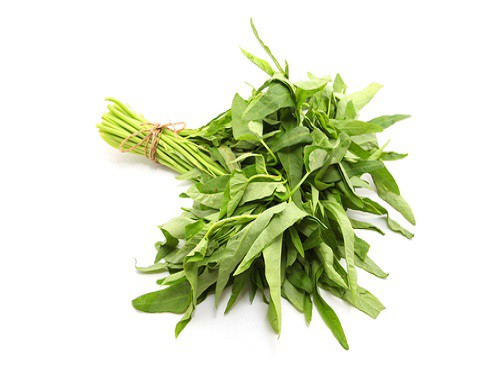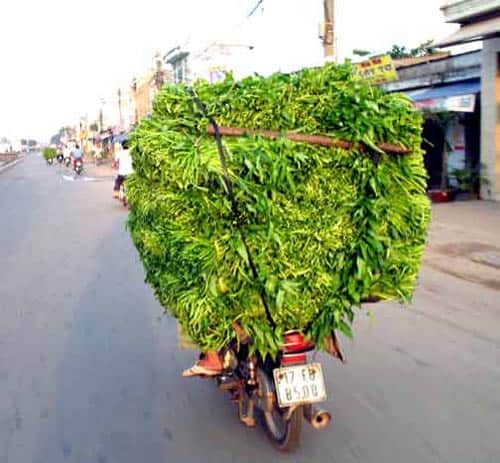water spinach or kangkong
Water spinach is a fast growing water weed forming hollow floating stems of 3 meter long . Kangkong is a popular food :The taste is like spinach and is a very cost effective vegetable. It is used in the kitchen of Southeast and East Asia, including southern China and Indonesia.
Water spinach (Ipomoea aquatica) is a plant that grows equally well in water or in soil. It responds dramatically in biomass yield and protein content when fertilized with biodigester effluent (Kean Sophea and Preston 2003), earthworm compost (Tran Hoang Chat et al 2005) or urea (Li Thi Luyen et al 2004; Tran Hoang Chat et al 2005)
Kangkong is very perishable
Kangkong has a very limited shell life, it should been sold and eaten directly after harvesting, storing in a refrigarator add only 2 or 3 days.
- Water Spinach has two major forms: Red-Stemmed (with pink to purple flowers) and White-Stemmed (with white flowers).
- White-Stemmed Water Spinach as a number of cultivars that can roughly be categorized as long-leaf (or narrow-leaf), broad-leaf, white-stemmed (pak quat), green-stemmed (ching quat), etc. There is no formal classification that I can find.
- Some consider the white-stemmed variety (pak quat) of the white-stemmed form as better tasting than others.
- There is growing research showing that the red-stemmed form has more health benefits.
- Edible Shoots – typically only the young and tender shoots are eaten, usually cooked.
- Edible Stems – typically only the young and tender stems are eaten, usually cooked. These stems are hollow and are crunchy when cooked. The stems require only a little bit longer cooking time than the leaves.
- Edible Leaves – can be eated raw or cooked (stir-fried, sauteed, boiled,
Both leaves and stems are edible and can be used as the way you use spinach.
growing Kangkong
It grows remarkably fast and need very little attention. Itis a plant that grows equally well in water or in soil. The growth rate increases dramatically in biomass yield and protein content when fertilized with biodigester effluent (), earthworm compost (Tran Hoang Chat et al 2005) or urea (Li Thi Luyen et al 2004; Tran Hoang Chat et al 2005)
growing water spinach indoor
The temperate climates are much to cold for the waterspinach .
Eating Kangkong
Only the young and tender shoots and stems and leaves are edible. They are eaten, usually cooked.
Growing Kangkong
The harvest is about 45 days after germination. The yield is up to 10 tons for an hectare. It is possible to reach about 100 tons /hectare /year , on the water about 90 ton ton/hectare/year.  The Kangkong is sold in bundels: If transported over long distances ( to the cities) its is placed on crushed ice.
The Kangkong is sold in bundels: If transported over long distances ( to the cities) its is placed on crushed ice.
Transportation in Vietnam. Motor bikes are the most important way of carrying farmproducts in Southeast Asia. The roads are bad , over congested. The towns teem with motorbikes weaving between cars, bicycles and pedestrians. No licence is needed for the smaller bikes, wearing a helmet is very hot, and often not done. The cities are polluted and crossing the streets is dangerous.
Kangkong is very perishable
Kangkong has a very limited shell life, it should been sold and eaten directly after harvesting, storing in a refrigarator add only 2 or 3 days. The Kangkong is sold in bundles: If transported over long distances (to the cities) its is placed on crushed ice.
feeding pigs
The older leaves and fibrous stems are used as animal fodder in tropical climates. Kangkong contains al the proteins that are needed and pigs likethe taste . In any area where this plant is growing too fast, it would make a great ancillary feed source.
Soil
Growing water spinach or kangkong needs evenly moist, wet and nutrient-rich soil of pH level around 6 – 7.
Sun
Kangkong grows in warm and humid subtropical and tropical climate, so it is essential to provide it full sun. However, it also grows in partial shade.
Growing kangkong from cuttings is easiest method to propagate it. Just cut several 30-40 cm long cuttings from young growth and plant 15 cm deep in potting mix.
Can be grown from seed, often soaked for 24 hours before sowing. Can be easily propagated from cuttings just below a node; Water Spinach freely roots at the node. One source explains that commercial operations will take cuttings approximately 12 inches (30 cm) in length (which will have 7-8 nodes) and plant them 6-7.5 inches (15-20 cm) deep.
Preparing the kangkong:
Buy the water spinach in fresh bundles : the stem must feel crispy and hollow, with an clear , fresh cut . Cut the leaves from the stem : the leaves can be cooked shorter then the stem , start by stir frying the stem for 2 minutes then add the leaves. Dont eat kangkong raw : the hollow stem sometimes contain parasites.
Kangkong and Sweet potato:
Ipomea aquatica (Kangkong, Water Spinach) leaves and does not contain oxalic acid in appreciable quantities, hence it has a nicer flavour than Batate or Sweet Potato leaves. Waterspinach can replace Sweet potato in place were the leaves of the Batate are eaten (Africa) (6)
Other members of the Ipomoae family :
reference
1 water spinach and fresh cassava leaves on growth performance. Pigtrop
2 Kean Sophea and Preston 2003
3 Tran Hoang Chat et al 2005
4 Li Thi Luyen et al 2004; Tran Hoang Chat et al 2005
6 Vegetables by G. J. H. Grubben

